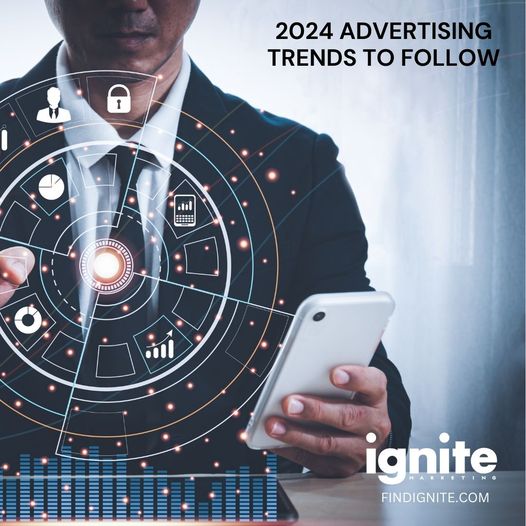As we approach the year 2024, it’s clear that the world of advertising is rapidly evolving. Emerging technologies and changing consumer behavior are reshaping the landscape, demanding new strategies and approaches from marketers. While information and analytics have driven advertising for decades, the future of digital marketing will be defined by an even greater focus on technology and ad personalization, with several key trends to watch.
The Rise of AI-Powered Marketing
Artificial Intelligence (AI) has been a buzzword for some time now, but its influence in the marketing landscape is only set to grow in the coming years. Contrary to the apprehensions of some, AI is not a threat (at least not yet) but a powerful tool that, when used appropriately, can revolutionize the way businesses advertise.
AI-driven advertising allows businesses to target their desired audience with precision, personalizing ads based on online behavior. This means that companies can reach the right people at the right time, with messages tailored to their specific interests and needs. Furthermore, AI enables businesses to optimize their advertising campaigns quickly and efficiently, ensuring they get the most out of their ad spend.
In addition to improving targeting and personalization, AI also enhances customer service through the use of chatbots. A huge step up from the automated phone support systems everyone loathes, these AI-powered bots can communicate with customers 24/7, answering queries and providing information, thereby enhancing the customer experience and freeing up human resources. They can provide instant responses to customer queries, offer personalized product recommendations, and even facilitate transactions. With improvements in AI algorithms and responses, chatbots are getting closer and closer to being able to pass the famous Turing Test, where an online questioner can no longer tell the difference between the responses of a computer and a human operator.
First Party Data: The New Standard
Another significant trend to watch is the increasing importance of first-party data. With privacy concerns on the rise, consumers are becoming more selective about the information they share. As a result, businesses are shifting their focus towards first-party data – information collected directly from their customers.
This shift promotes transparency and trust, as customers know exactly what information is being collected and how it’s being used. You’ve probably noticed a lot more GDRP (General Data Protection Regulation) compliance, which has been in effect in the EU since 2018, on many websites, allowing you to accept, opt-out, or adjust cookie settings. In the United States, California, Colorado, and Virginia have passed legislation regarding online privacy, transparency, and data collection.
Moreover, first-party data tends to be more accurate and relevant, enabling businesses to create highly targeted and effective advertising campaigns instead of purchasing lists of names and emails and blasting out advertising shotgun-style hoping for a few hits. Plus, engaging existing customers who are already familiar with your product and brand helps retain them as future customers.
Dominance of Video Marketing
Video marketing is another trend that’s set to dominate the advertising landscape in 2024. With consumers increasingly consuming content through video, businesses are recognizing the power of this medium to engage audiences and convey their brand message. From short-form videos on social media to longer, more detailed explainer videos, the possibilities are endless.
According to Statista, spending on mobile video ads will exceed $50 billion by 2025, with the trend being for shorter and shorter video ads. With the increasing popularity of short-form video platforms like TikTok and YouTube Shorts, it should come as no surprise that one survey found that 25% of adults will close a video after only 10 seconds, and more than half close it by the 20-second mark. The mantra of less is more will likely dominate video marketing, with short, catchy, and immediately accessible videos performing the best.
Voice Search
Voice search optimization is becoming increasingly important in the advertising world as more consumers are using voice assistants like Siri, Alexa, and Google Assistant to find information. This shift towards voice search is largely driven by the convenience it offers — users can search for information hands-free while multitasking.
This growing trend has significant implications for advertisers. Traditional keyword strategies that work for typed searches may not be as effective for voice searches. When people use voice search, they tend to use more natural, conversational language. They’re also more likely to phrase their searches as questions. For instance, instead of typing “weather New York,” a user might ask their voice assistant, “What’s the weather like in New York today?” To optimize for voice search, advertisers need to incorporate these long-tail keywords and question phrases into their content.
Multichannel programmatic advertising
Multichannel programmatic advertising is quickly becoming a game-changer in the digital advertising landscape. This technology-driven approach allows advertisers to automate the process of buying, placing, and optimizing ads across multiple channels, making advertising campaigns more efficient and effective.
In traditional advertising, the process of ad buying involves manual negotiations and transactions, which can be time-consuming. However, with programmatic advertising, this process is automated through a real-time bidding system. Advertisers can specify their target audience, budget, and campaign goals, and the system will automatically purchase ad spaces that meet these criteria. This not only streamlines the ad-buying process but also ensures that ads are shown to the right people at the right time (remember how we mentioned AI earlier?).
Programmatic advertising also allows for multichannel marketing. Advertisers can distribute their ads across various platforms such as websites, social media, mobile apps, and even connected TV. This is particularly beneficial in today’s fragmented media landscape, where consumers are spread across numerous digital touchpoints. By adopting a multichannel approach, advertisers can reach their audience wherever they are, increasing their chances of engagement.
As we move into 2024, businesses must keep these trends in mind to stay ahead of the curve. The future of advertising lies in harnessing the power of technology and personalization to deliver relevant, engaging, and effective campaigns. Ignite Marketing is here to help businesses navigate this exciting new landscape and make the most of these emerging opportunities.

